Pillbox ballistics (2)
Posted: 18 February 2007 21:51
Continuing my examination of possible wartime damage to a Type 22 pillbox beside the Royal Military Canal at Ruckinge, I'm going to concentrate on the damage indicated by the area shaded in red below.
The damage to the embrasure is extensive, but it is harder to come to any firm conclusion about it.
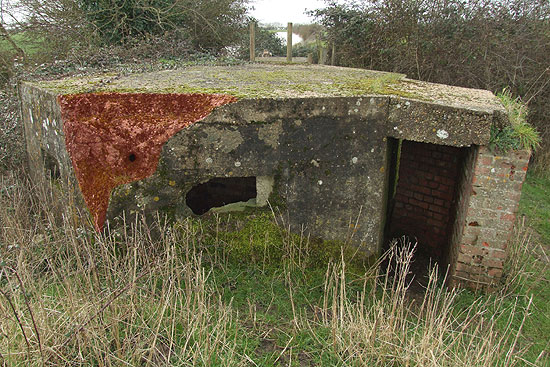
This is the damage as seen from inside; the inner surface has been scabbed as a result. Interestingly, there was no evidence of any reinforcement in the concrete that I could see.
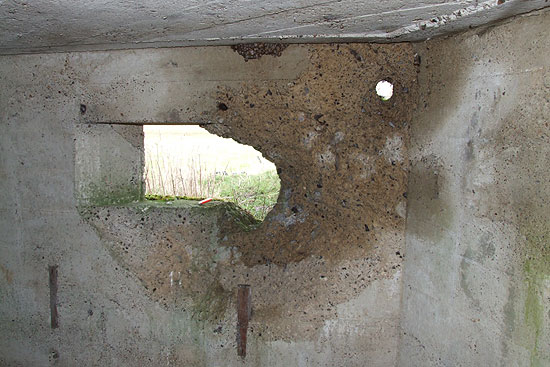
The photo below shows what I was hoping to find on the interior walls of the pillbox; evidence of projectile impact.
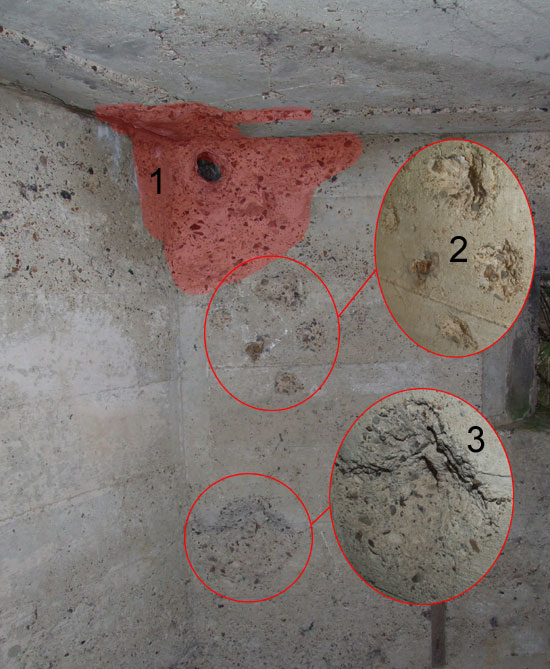
This damage is in the corner facing that which bears the external damage. The three areas are as follows:
- Single entry hole (at least 23cm deep) surrounded by scabbing (indicated in red)
- Group of small dents
- Single entry hole 75mm deep
We'll be looking at area #1 in most detail, as it is this damage that I think I can make some comment on, from the assessment that follows.
I should state that I'm not an expert on ballistics and that my methodology would perhaps not stand up to scientific rigour, but it was fun!
Having watched too many cop movies where forensics teams run a line from a bullet hole to trace the trajectory and work out where the gunman was shooting from, I decided that I would give this technique a go.
I was hoping to see if I could associate any of the impacts with the entry hole, as casual observation did not make it clear if impacts #1 or #3 were possible destinations of a projectile that caused the hole.
Sticking a pole in the ground outside the pillbox in line with the hole, I passed the string through the centre of the hole and ran it along to the centre of impact #1.
Below is the string as seen from the impact wall:
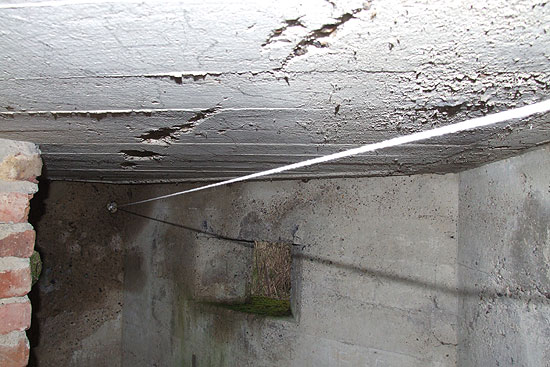
And now looking in the opposite direction at the impact area:
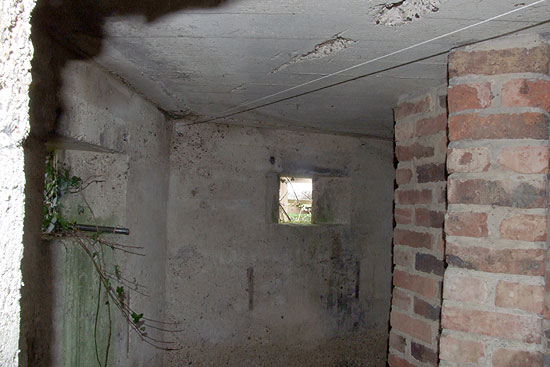
Even at this point, I wasn't totally sure that impact #3 hadn't perhaps been associated with the hole, but one thing that ruled this out for me was a closer look at the ceiling of the pillbox.
In both of the above photographs, there is evidence of concrete having been gouged out of the roof slab. While I have seen similar isolated damage in other Type 22s, in this instance, the alignment and orientation of these three gouges followed the line of string perfectly as seen below. (I've coloured the string black to make it stand out).
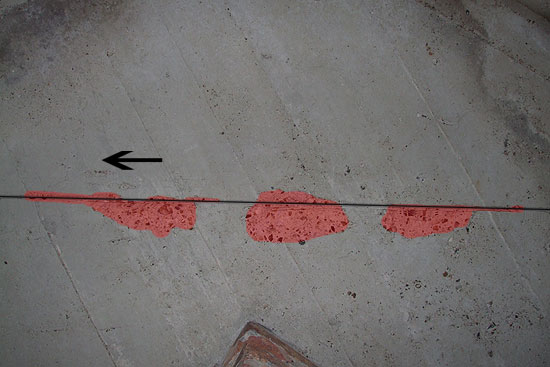
What actually caused this scarring is not certain; it would appear unlikely that the projectile itself would have impacted several times along the ceiling, so maybe debris from the penetration was carried along and thrown up, or pehaps the projectile was beginning to break up.
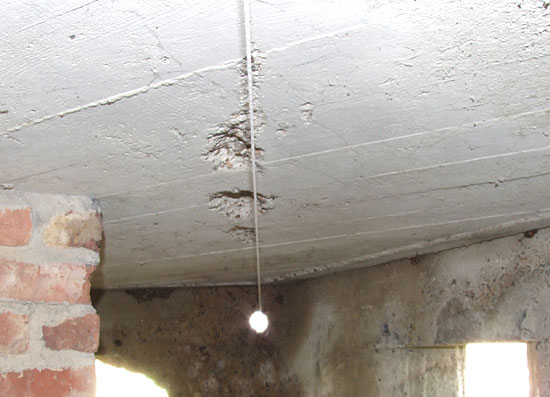
I was satisfied enough with this to be able to produce the diagram below. It should be noted that the basic Type 22 outline seen here is NOT strictly based on the pillbox at Ruckinge, but one closer to Appledore that I surveyed last year. The diagram was a pre-existing one that I hurriedly modified.
The embrasure design in the diagram has an extra step, and the location and size of the internal blast wall may not be exactly in scale with the outer walls (which are to scale).
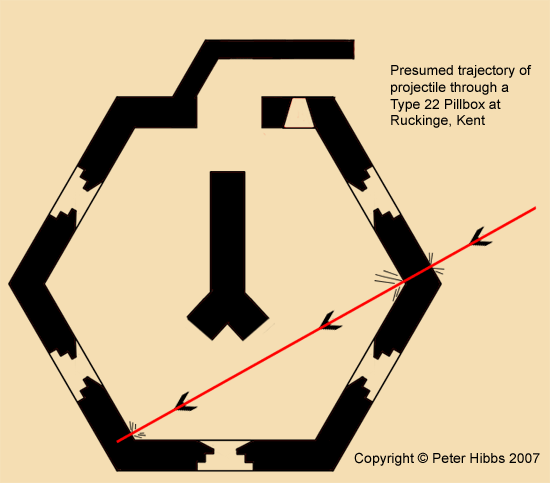
So what weapon caused this damage? The photo below shows the entry hole from the inside. It's hard to actually measure the diameter of the hole with a metal tape measure, and the irregular surface caused by the loss of pieces of ballast that were part of the concrete mix make it difficult.
However, it would apear to give a shot calibre in the region of 60mm. More precise measurement might reveal 57mm, in which case it's quite likely that the weapon was the 6-pounder anti-tank gun.
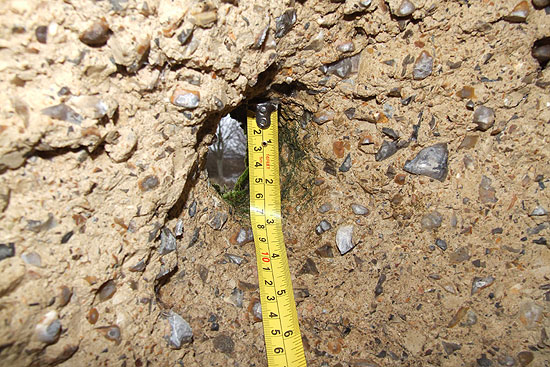
Was this the only shot fired at the pillbox? Possibly not; looking at the extent of the external damage below, the entry hole is not central to the damage as you might reasonably expect. This might perhaps indicate that at least one other round was fired at this corner of the pillbox, dislodging a volume of concrete from the thick roof slab before the successful penetration just below roof level. Again, this is just a guess.
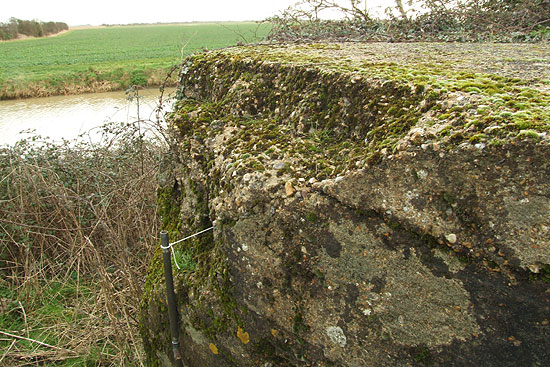
Where was the weapon that fired on the pillbox situated? Looking through the hole from inside the pillbox we see the view below. A compass aligned on the string indicated a bearing of approximately 66-68°.
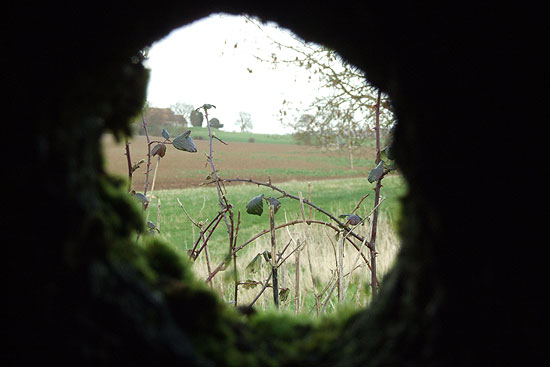
Marching on this bearing I advanced about 70m before I came up against a water-filled dyke (effectively along the line in the above photo where the grass meets the ploughed field).
The photo below was taken from here. The red dot indicates the entry hole. Note the ground level; the area is flat, but the pillbox is dug into the original parapet of the canal.
The shot that penetrated must have been from a relatively low-profile weapon (i.e., probably not a tank gun), as the impact hole is slightly higher than the entry hole. The pillbox roof and embrasure sills all registered as level, so if the pillbox has moved at all over the years, it's only sunk at an even rate.
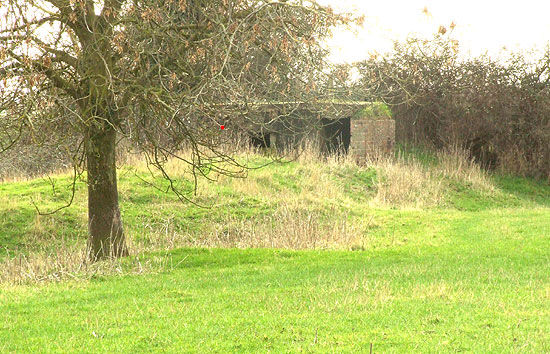
What of the damage to the embrasure? Let's look at the internal scabbing again (photo below); that associated with the shot hole is red, the embrasure damage is blue.
There are two points to note here; firstly, the red damage appears to overlap on top of the blue, indicating the embrasure damage as being older.
Secondly, the almost circular nature of the blue area (interrupted only by the discontinuity in the wall caused by the embrasure), perhaps indicates that only one trauma caused this.
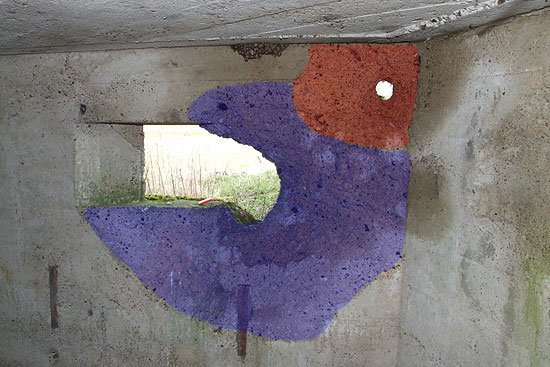
As the extent of the damage is much wider, was it caused by an explosive charge placed against the outer wall of the pillbox? The weakness of a pillbox wall would be around an embrasure, so this would be a logical place to set a charge.
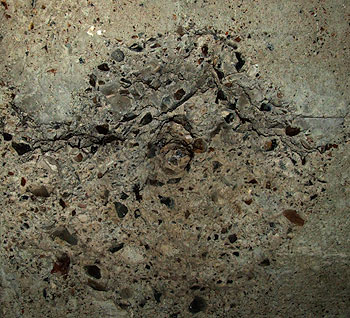
It's harder to speculate on this damage; areas #2 and #3 on the far wall are also unaccounted for.
However, it may be that impact #3 (seen at left) and the embrasure damage are connected; a document in WO 195/5385 detailing 1943 experiments using explosives to neutralise pillboxes talks about a slug from the explosive charge (incidentally, placed near an embrasure) causing a crater on the opposite wall.
Impact #3 is about 20mm in diameter, with the crater about 19cm across. 20mm was not a standard ground weapon calibre used by the British Army, and this is too large for the .50 cal US or .55 Boys rounds, so it may well be a slug from an explosive charge.
Does this describe what happened here? I don't know; one thing that confuses me is that the internal blast wall bears no real sign of damage.
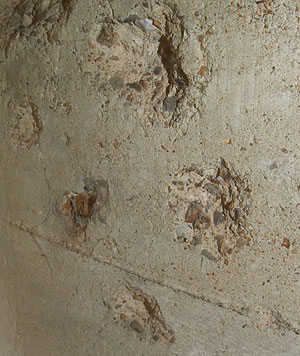
In relation to impact #2 (the group of five small dents, seen at right), I have no firm idea.
I originally thought they might be .303 bullet impacts, but I don't think they're deep enough, although they do look like a deliberate grouping.
They're also different sizes and so may just be debris marks caused by the projectile impact.
To sum up, it would appear that the pillbox experienced at least two traumas; the detonation of an explosive charge beside an embrasure and the passage of a projectile through the same wall, impacting on the opposite wall inside.
I should again stress that my methods of arriving at this conclusion are based on a layman's common sense and empirical evidence that relies on a certain predictability of the effects of explosives and ballistics.
The reports I've read on the design and construction of air raid shelters as well as experiments on pillboxes all show that the behaviour of buildings in the presence of phenomena such as blast is not as predictable as I would like it to be.
Proper measurement to confirm the calibre of projectile would be useful, as would the string technique applied to impact #3 to try and determine whether it could have come from the centre of the embrasure damage. I may undertake another visit at some point to attempt this.
So, was it all worth it? To me, yes; I'm satisfied that the damage is wartime, which is something I wasn't sure about before I started looking at it closely.
To most other people it probably confirms my insanity - all this effort to caption a single photograph, and there's over 300 in my database...
- Pete

Email:
Blog Latest

Bishopstone reveals its pillbox secrets
18 October 2021

Pillbox or Observation Post?
10 June 2020

Uncovering the hidden secrets of a pillbox
8 June 2019

Review of 2018
31 December 2018

Wartime Christmas in East Sussex (2)
24 December 2018
Jargon-buster
Embrasure
A loophole or slit that permits observation and/or weapons to be fired through a wall or similar solid construction.
Pillbox
Generic term for a hardened field defensive structure usually constructed from concrete and/or masonry. Pillboxes were built in numerous types and variants depending on location and role.

Type 22 pillbox
A small hexagonal pillbox for six men not commonly seen in East Sussex, though a few still survive along the Royal Military Canal stop line.
This site is copyright © Peter Hibbs 2006 - 2024. All rights reserved.
Hibbs, Peter Pillbox ballistics (2) (2024) Available at: http://pillbox.org.uk/blog/216521/ Accessed: 27 July 2024
The information on this website is intended solely to describe the ongoing research activity of The Defence of East Sussex Project; it is not comprehensive or properly presented. It is therefore NOT suitable as a basis for producing derivative works or surveys!